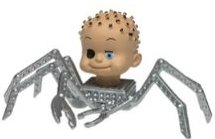that Sid created in the movie "Toy Story" by taking parts of different dolls and putting them together.


I began this page back in 2009 aimed at Ancestry trees. But now it is there on other online sites, such as FamilySearch's online tree. Here are three examples of what I mean.
Example 1: "Vickles" Butson
The family of Solomon Butson and Jane Keam who married and had all their children at St. Blazey, Cornwall never contained a son named "Vickles". However, a transcription error in the 1861 Ontario marriage record of their son Nicholas Keam Butson recorded him as Vickles Butson. (I presented the full details of this problem, with images of the original records in an Ancestry Butson board post.) Ancestry does not have the original document; there is only an index reference. So people cannot see the original image. The result is that a number of Ancestry.com member family trees show "Vickles" Butson as a son of Solomon and Jane. The members have created a new "son" instead of properly attaching the record to the real son Nicholas Keam Butson.
This problem has then compounded itself in some members' trees. Since they have made the original error of fabricating the non-existent son "Vickles", when they see the 1851 (really 1852) census that shows Nicholas with a handwritten form that can be misread as Vicholas, they then assume that they have found yet another record to support the existence of "Vickles", and they compound their error.
Example 2: Solomon Butson's Sons in Canada vs. Isaac Butson's Sons in St. Agnes - 1841
Among other children, Solomon Butson and Jane Keam had sons William, John, Henry and James -- all born at St. Blazey, Cornwall (on the south coast). All of them were in Canada by the end of 1840 and thus never appeared in the 1841 English Census.
However, the 1841 English Census does include Isaac Butson's family at St. Agnes (on the north coast), including Isaac's sons William, John, Henry and James. So careless Ancestry.com members have latched onto the 1841 English Census record of Isaac's family in St. Agnes and attached it to one or more of the sons of Solomon Butson. The same surname, the same given names of the brothers, Cornwall ... but entirely different families, and linking this 1841 Census record to Solomon's sons is a significant error.
Example 3: Jannes & Gerrit van Wijk of the Netherlands vs. Johannes Abraham & Gerrit of South Africa
Tracing their Dutch immigrant ancestors back to the Netherlands, several Ancestry.com member family trees correctly identify Jannes van Wijk as the father of the immigrant. And they correctly identify Gerrit van Wijk as Jannes' father. However, they also conflate this father-son duo with a similarly named South African father-son (Johannes Abraham & Gerrit) and then trace back many more generations of entirely spurious ancestors.
The real ancestor Jannes and his father both were born, died, and are buried in the Netherlands and never went to South Africa. There is abundant evidence (baptisms, marriages, consent documents, military records, pension records ...) that prove that this is so. However, these records are not on Ancestry.com. So the armchair researchers have found something else in Ancestry -- probably another family tree -- that happens to have the right father-son names at about the right time and even though they are half-way round the world, the Ancestry.com members have equated the two pairs.
The conflation of the two pairs should have been caught immediately as an error. By equating the South African and Netherlands Gerrits, the result is that the spurious unified Gerrit was married one year before he was born. And he had five children by the time he was six years old.

These are our ancestors, and we cannot pick and choose how we put them back together. They were who they were, and the task is to find out the truth and to see them as they really were and not in some distorted version.
Ancestry.com is an excellent tool -- if you exercise careful judgement and evaluate the sources carefully.
If you are creating your own tree as an Ancestry.com member, here are some guidelines to keep in mind, so that you do not create a "Toy Story" family tree.